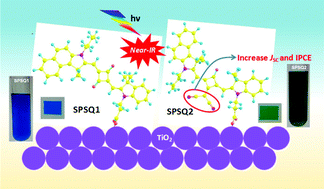Near-infrared unsymmetrical blue and green squaraine sensitizers†
Abstract
Two novel panchromatic asymmetrical squaraine sensitizers (SPSQ1 and SPSQ2) have been synthesized, characterized and effectively used for TiO2-based dye sensitized solar cells. In a solution, both dyes display a highly intense near-IR absorption (SPSQ1; 651 nm and SPSQ2; 692 nm), the red shifted absorption of SPSQ2 was attributed to the incorporation of the auxiliary acceptor dicyanovinyl unit on the squaraine moiety. Interestingly, the dicyanovinyl unit lowered the LUMO level of SPSQ2, which decreased the band gap and red shifted the absorption when compared to SPSQ1. These dyes possess suitable HOMO and LUMO levels to work as efficient sensitizers in DSSCs. The experimental trends in their optical and electrochemical properties are well matched with the theoretical calculations modeled by TDDFT. The blue and green color of the devices showed their complementary absorption and harvest a greater number of photons from solar flux. Under standard global AM 1.5 G solar conditions, the DSSC based on SPSQ2 exhibited a high power conversion efficiency of 3.1% with a high short circuit current density (JSC) attributed to the broadening of the IPCE spectra in the UV-vis and near-IR regions when compared to SPSQ1 (2.5%).


 Please wait while we load your content...
Please wait while we load your content...